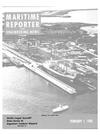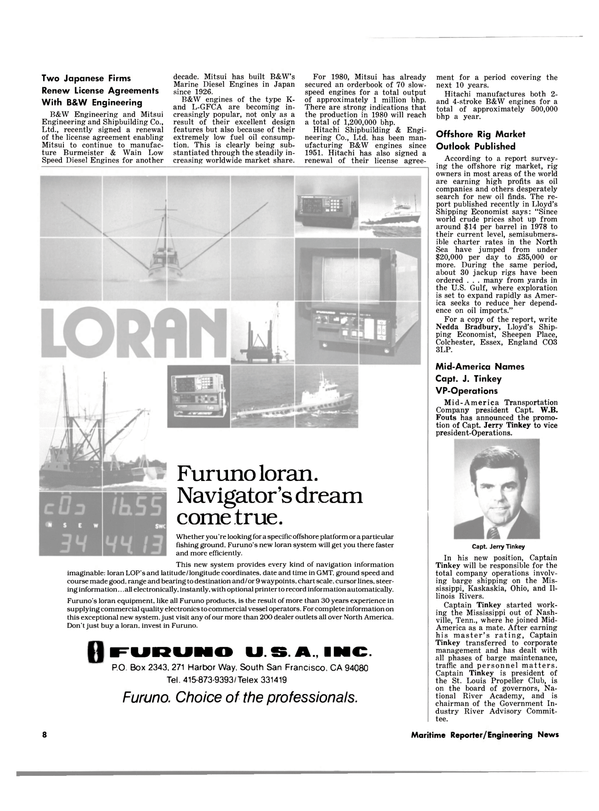
Shipbuilders Council Reports U.S. Shipbuilding Produces Net Plus Economic Effect
A recent report on "The Economic Impact of the U.S. Shipbuilding and Ship Operating Industry" by Data Resources, Inc.
(DRI), commissioned by the Shipbuilders Council of America, demonstrates that the net effect of building ships in the U.S. is significantly positive. The following is a digest of the DRI report purposes, methodology, assumptions and findings as it appeared in a recent issue of the Council's publication "Shipyard Weekly." Purposes: (1) General: To establish credible . analytical mechanisms for measuring the economic impact of various maritime policy options g i v e n a s s u m p t i o n s concerning (a) Size of U.S. merchant and Naval fleet; (b) U.S. vs. foreign construction of merchant ships; (c) U.S. vs. foreign financing; (d) Tax and subsidy structure; (e) Change in government spending occasioned bv policy options.
(2) Specific Tasks—For the 1980- 1990 Period: (a) To determine the economic impact of increased U.S. naval ship construction and U.S.-flag commercial ship construction and operation over the expected baseline (89 merchant ships) in the absence of any policy change; (b) To assess the impact of building ships in the United States with constructiondifferential subsidy (CDS) as opposed to building abroad for operation under U.S.-flag with o p e r a t i n g - d i f f e r e n t i a l subsidy (ODS).
Methodology: DRI macroeconomic model is adjusted for first round changes, under each policy option, in balance of payments, domestic investment, imports, Federal subsidy levels, and similar considerations.
The model then calculates the net economic impact, which is disaggregated by the DRI input/ output model to obtain industry detail which, in turn, is used to calculate regional impacts.
Results of Increased U.S. Naval and Merchant Marine Program: (1) Assumptions: (a) The U.S.
adopts a policy enabling U.S.-flag owner/operators to hold present market share of trades with developed countries and to attain the following shares of U.S. trade with developing countries of the 1980-90 period—liner, 40%, dry bulk, 20%, short haul liquid bulk, 20%, long haul liquid bulk, 10% ; (b) This policy would result in building approximately 300 commercial vessels, in addition to baseline fleet forecast, for U.S.- flag operation over the period. All ships would receive CDS, ODS and Title XI mortgage guarantees; (c) The naval program would be expanded from 67 to 96 ships over the 1980-84 period and naval expenditures would remain at the increased level for the 1985-90 period; (d) The Federal budget would not be increased to fund additional CDS and ODS outlays, rather other programs would be reduced (prorated for each major category of government spending). (2) Net Impact on Total U.S. Economy of the Expanded Maritime Program in 1980-1990 Period: (all expressed in 1978 dollars) (a) GNP would rise by $17.2 billion; (b) Investment in durable equipment would rise by $15.2 billion; (c) Net nonmerchandise imports would fall— down 1.77c by 1990. As balance of payments improves, pressure on the dollar would ease; (d) Inflation impact would be nominal (about .02% average) ; (e) Annual Federal deficit would fall by $1.3 billion average; (f) Net employment increase in shipyards and supnorting industries would total 1,846,000 man-years. (3) Major Related Tndustrv Impacts Over the 1980-1990 Period: (final sales and employment) ; Results of Policy Encouraging U.S. Versus Overseas Construction of U.S.-Flag Commercial Ships For Operations With ODS: (1) Assumptions: (a) Same 300-ship incremental program as described above. Naval program would be held constant (at expanded level) so as not to affect results; (b) First round Federal expenditures would be held constant.
In the case of building abroad, CDS savings would be reallocated to other governmental programs.
(2) Net Impact on the U.S. Economv of Ruilding the Ships in U.S.
With CDS Instead of Abroad: (1978 dollars) (a) GNP would rise $15.3 billion over 1980-90; (b) Domestic investment would rise by $19.8 billion. The fact that the investment would exceed total GNP impact indicates that the policy creates a ship from consumption to investment as well as increasing overall economic welfare. Further payoff in the form of downstream productivity improvement could also be expected (c) Nonmerchandise imports would be down 1.1% by 1990; (d) Inflation impact would be nominal (about .03% average) ; (e) The Federal deficit would decrease by an annual average of $1.7 billion over the period. It should be noted that the Federal deficit would be reduced even if the Federal budget is increased to fund CDS. Initial outlays would be higher, but subsequent tax revenues would more than recoup initial CDS payments.
It should be further noted that the results presented here are very conservative with respect to the total economic impact of the U.S. shipbuilding industry. A decision to fund all or part of the program by increasing the Federal budget would boost sales, GNP and employment effects dramatically.
For example, in the combined Navy/commercial program, net GNP increase would total $64.5 billion over the period and net increase in employment would exceed 4,000,000 man/ years, if the entire cost — $24.9 billion in naval spending and $8.7 billion in increased subsidies — is funded from increased government spending.
Read Shipbuilders Council Reports U.S. Shipbuilding Produces Net Plus Economic Effect in Pdf, Flash or Html5 edition of February 1980 Maritime Reporter
Other stories from February 1980 issue
Content
- Four 600-HP Pusher Tugs Completed By Valmet page: 6
- H.J. Ruehsen Of Bethlehem Steel Addresses SNAME Chesapeake Section page: 6
- Shipbuilders Council Reports U.S. Shipbuilding Produces Net Plus Economic Effect page: 6
- Riverway Shipyard Delivers 50' Towboat To Corps Of Engineers page: 6
- Two Japanese Firms Renew License Agreements With B&W Engineering page: 8
- Robert Sanders To Yard Superintendent page: 8
- Andino Appointed VP At Crowley Maritime International Division page: 11
- New Literature Offered On Gems Level Switch For Corrosive Media Use page: 11
- Phillip Gresser Associates Will Move Offices To Palm Beach, Florida page: 11
- Mangone Building New Special Purpose Tanker For Sun Transport page: 12
- Tandanor, S.A. Installs World's Largest Shiplift page: 12
- Fitzgerald To Head MarAd Title XI Program page: 12
- First Of Two For Waterman -S/S Benjamin Harrison- Christened At Avondale page: 12
- Wiley Completes Ferryboat Surry To Operate At James River Crossing page: 12
- MarAd Appoints Neumann Maritime Aids Deputy page: 14
- NASSCO Delivers 188,500-DWT ARCO Alaska To Arch Tankers page: 14
- Norwegian Order For Cargo Carrier To IHI page: 15
- Acadian Will Build Up To Four Clipper-Class Container Feeder Ships page: 15
- Thompsen Appointed VP At Jackson Engineering page: 15
- National Marine Adds Drydock And Fabrication Shop To Shipyard page: 16
- Wendt Named President Of Sperry Division page: 16
- De Laval Separator To Become Alfa-Laval, Inc. page: 17
- Parsons Brinckerhoff Will Develop Boston Container Terminal page: 17
- Free Bulletin Offered On Marine Alternators For Work, Crew, Supply Boats page: 17
- Superseiner Napoleon-First Of Three- Delivered By Peterson Builders page: 18
- Rossway Named VP Of Twin City Shipyard page: 18
- Sayville Ferry Service Adds New Vessel To Fleet page: 18
- Fink And Calvert Named At Wichita Clutch Co. page: 18
- $120-Million Amoco Jacket Contract Awarded To McDermott Scotland page: 20
- E.J. Murphy Made Senior VP Of Coscol Petroleum And Coscol Marine Corp. page: 20
- Chesapeake Section SNAME Hears Ocean Energy Systems Paper page: 20
- Top Management Changes Announced By Lockheed page: 21
- Millard Named Deputy Managing Director Of Mooremack, South Africa page: 21
- Toronto-U.S. Ferry Service Subject Of MarAd Study page: 22
- Three Appointed To Key Positions At Morris Guralnick Associates page: 22
- M/V National Energy Christened In New Orleans page: 24
- Literature Offered On New Harris RF Communications Synthesized Transceiver page: 24
- Atlantic Marine Delivers 74' Combination Trawler John Gregory page: 24
- Second Winter Trawler Delivered By Valmet page: 27
- Am-Can To Start Tug-Barge Service On Great Lakes In '81 page: 27
- Second Tsavliris Bulkcarrier Delivered By CCN page: 29
- McDermott Develops New Pipeline Welding System —Literature Available page: 29
- Top Executives Promoted At Curtis Bay Towing page: 34
- Free Brochure Available On Saab Microwave Tank Level Gauging System page: 34
- Wayne Musgrove To Head New Chem-Marine Corp. page: 34
- Santa Fe To Install 2 Production Platforms For Union Oil Company page: 36
- Texaco Names Quegan Ass't General Manager Fleet Operations page: 36
- Santa Fe Names Three To Top Management Posts page: 36
- NABRICO Delivers Four Of Six New Barges To Hollywood Marine page: 36
- Decker Named VP And General Manager Of Sperry Gyroscope Unit page: 38
- McGraw-Edison Names R.V. Jeck President Of Worthington Pump Unit page: 39
- Booklet Available From Kaiser Chemicals On Corrosion Protection page: 39
- Bridgestone Receives $5-Million Order For Hose For LOOP Terminal page: 39
- MTU/North America Opens U.S. Corporate Headquarters In Houston page: 39
- Blount Marine Delivers Innovative Cruise Ship New Shoreham II page: 40
- San Marcos Purchases Vessel For Conversion In Japanese Yard page: 40
- Jackson Engineering Names Paul Reynolds Supervisor, Coatings Dept. page: 40
- Three Promoted At J.J. Henry Moorestown Office page: 41
- Swiftships Completes The Streljko For Yugoslavian Owners page: 41
- ASNE So. New England Section Hears Gen'l Dynamics Paper On LNG Spheres page: 41
- Parker Towing Barge And Towboat Project To Cost $14 Million page: 42
- Bird-Johnson Names Gulf Coast Manager page: 42
- Literature Describes Expanded EPSCO Radar Line page: 42
- NOAA Survey Of Remotely Operated Vehicles Available page: 43
- Inter Island Conference Set For March 11-14 In Manila, Philippines page: 46
- New Hose Breakaway Coupling Prevents Spillage —Literature Available page: 46
- Crescent Towing And Salvage Establishes An Alabama Division page: 47
- Galleon Shipping Expands— Adding 9 Multipurpose Ships page: 47
- Conoco Plans Tension Leg Platform For N. Sea Depths To 2,000 Feet page: 47
- J.J. Krebs To Head Board Of Commissioners At Port Of New Orleans page: 47
- Hitachi Delivers Pertamina 1021 To Scorpa Pranedya Navigation page: 48
- Is A Big Bulk Carrier A Good Bet? page: 48
- Halter Awards Contract For $3.5 Million To Gulf Coast Refrigeration page: 49
- Key Promotions At Lockheed Shipbuilding page: 49
- Marathon Delivers Jackup Rig For China page: 50
- Ocean Salvors And Crescent Towing Add Gulf Salvage Station page: 51
- Ten EB Engineers Deliver Papers At Fourth Annual Honors Seminar page: 51
- Aerospace/Marine Technology Compared In New Book Available From SNAME page: 51
- Four VLCC Supertanker Conversions To Include Megasystems Seamatic II page: 52
- Port Of Portland Elects Officers For 1980 page: 52
- RCA Globcom Completes China Marisat Tests page: 52
- Literature Available On Rockwell's New High Pressure/Temp. Valves page: 53


